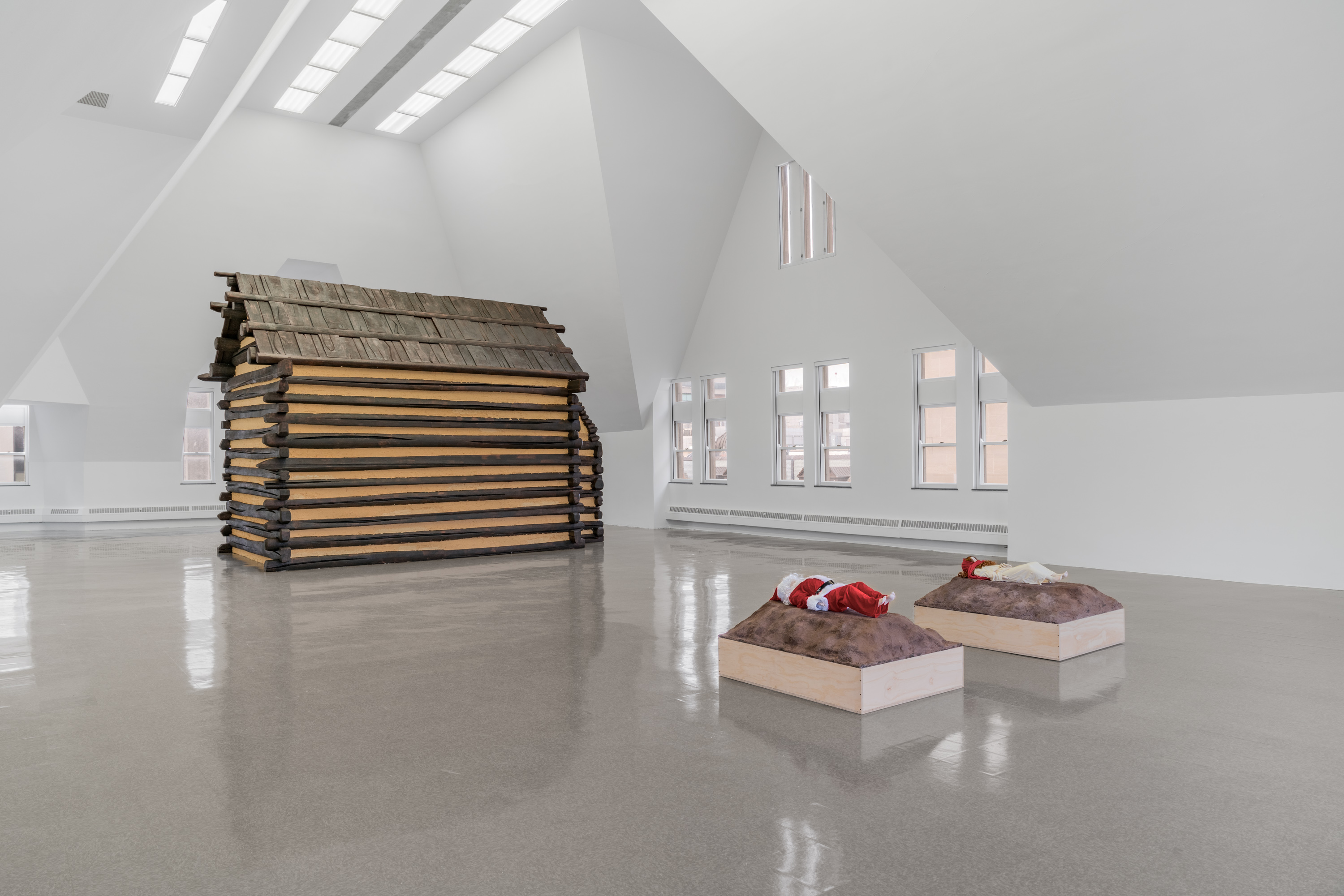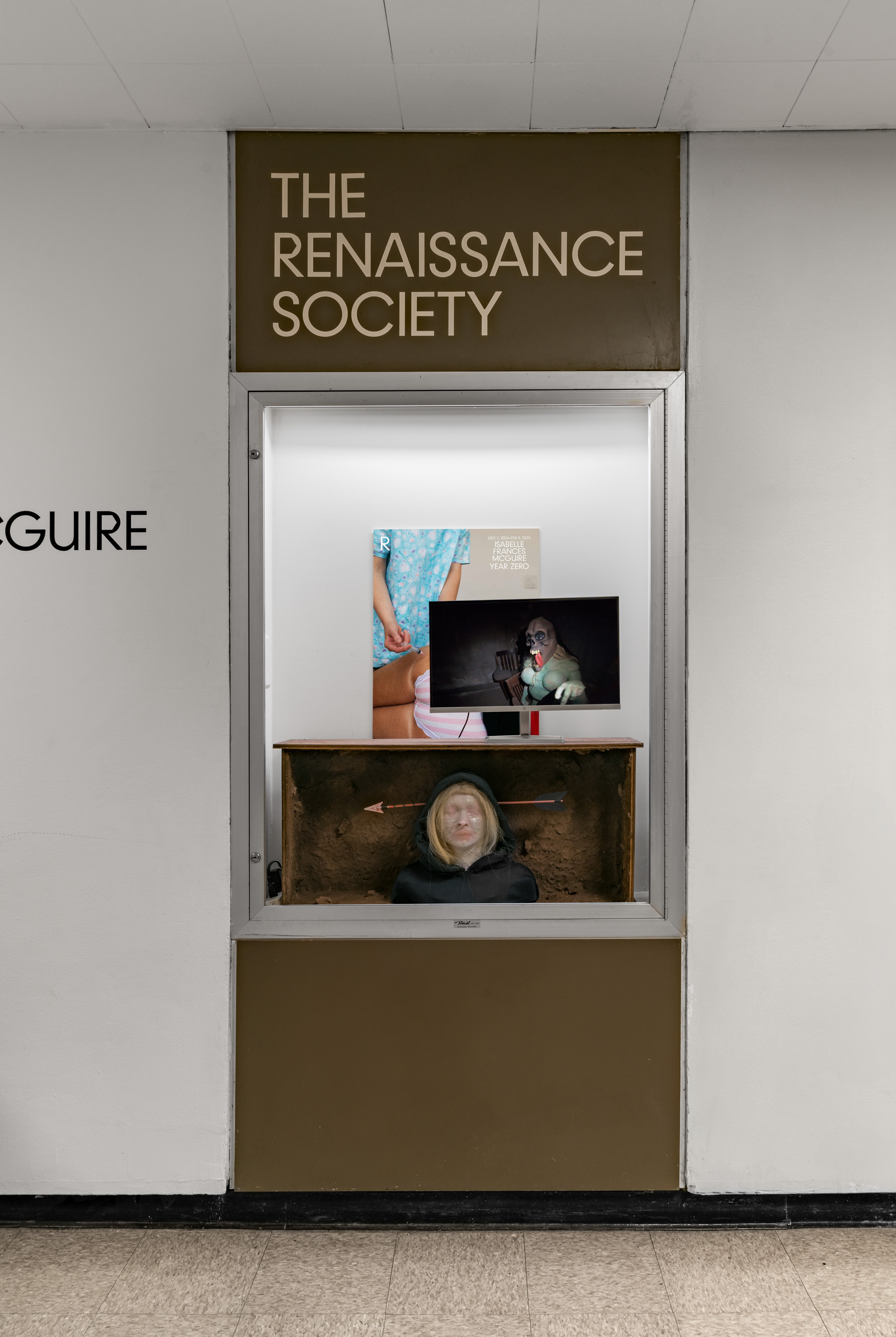Review / 4 February 2025 / By: Josh Brolin / ★ ★ ★ ★
Isabelle Frances McGuire’s Year Zero at The Renaissance Society, Chicago.
Isabelle Frances McGuire’s Year Zero at The Renaissance Society, Chicago.
Isabelle McGuire has given us an America in tripartite form. Inside her show Year Zero at The Renaissance Society in Chicago, a life-sized recreation of Abraham Lincoln’s birthplace cabin, whose ‘real’ equivalent (Kentucky’s ‘Abraham Lincoln Birthplace National Historical Park’) is itself a facsimile cabin, alongside two slightly undersized figures of Santa Claus and Jesus, who prostrate on wood-and-dirt-mound pedestals. These cultural figures’ apparent exhumation, however, feels almost entirely depoliticized, positing them in the press release as “‘revisiting the past, re-animating old models, or re-wilding familiar symbols”. This seems like a poetic way to say that you’re picking and choosing from a cultural consciousness that you know will be shared but defining it as active engagement. I am more inclined to feel that “re-wilding” is predominantly passive: a languorously ironic presentation of referents, successfully bolstered by confident and considered choices of material and scale. It does not share the high buzz that McGuire’s more directly funny work exudes - a child’s call of duty cosplay and animatronic baby Yoda at King’s Leap, SuperBaby2(Unmanned) {“The Child”, “Reborn”} (2023) spring to mind. But the eerier tone (the Lincoln house approximates the haunted house) provides visual dividends for a show of empty spaces and characters to be projected onto, even vampirised ones. I enjoy work that pokes at open-ended interpretation, and there are lots of threads to tug, but don’t tell us to look out for it in the accompanying text. Reticence works far better when simply shown, not didactically spelt out.
The Renaissance Society occupies the odd position of being Chicago’s closest approximation of the Kunsthalle format, geared toward commissioned work by living artists. TRS has shown Ghislaine Leung and Aria Dean - always leaning towards reasonably reticent content which balloons to gorge on its own context, for better or worse, under the guises of various forms of sculpture and new media practices, with a yearly-ish dense yet star-studded group show. This is fine and usually stands out in Chicago, not only due to its usually high quality, but by a relative dearth of that form of contemporaneity’ in other art spaces. Given the literal academic backdrop of the space (on the UChicago campus), all the vitrine installations in the hallway vaguely blended in with the incessant postering of doors and walls you see if you climbed the four flights up to the show. Supplementary material, choices for how you might approach the work in the main space, completely separated from the grist of the exhibition. It sucked because McGuire’s sole video in this, Frankenstein in the Underworld (2024) shown in a vitrine, was fucked-up and really good. It firmly illuminated a strain of body-mod which runs through the show. The two disinterred figures are qualified as “bodies printed from medical CT scans of anonymous women” in the accompanying text and fit nicely with McGuire’s previous relation to kitbashing (creating new models from an assortment of different parts) and video game culture.
The show poster, Depo Provera (2024) a work in itself, listed on the checklist - which I don’t think I’ve seen before - shows a staged photoshoot of McGuire injecting her mother’s behind. It was named after a dubiously effective hormonal birth control her mother had been taking while pregnant with McGuire. This oddly heart-warming personal history complicates the previous historical referents. But, when combined with the specificity of the CT scans and the exclusively male personae in the work, spins a discussion around the agencies of differently gendered bodies. Year Zero (alt-history, rebirth, cycles, sublimation, etc.) is a satisfying show, and at its base has a tonal consistency and specificity that I very much appreciate, even though that was exactly what I expected. More of this in Chicago, I think.

